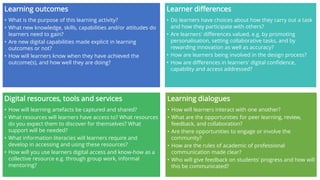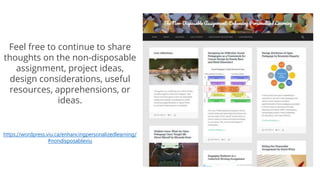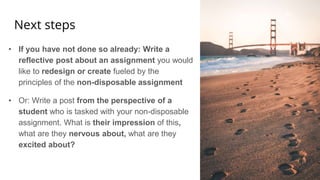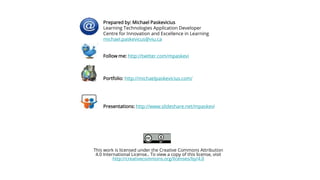The Non-Disposable Assignment: Enhancing Personalised Learning - Session 2
- 1. The Non-Disposable Assignment: Enhancing Personalized Learning Michael Paskevicius & Liesel Knaack Centre for Innovation and Excellence in Learning
- 2. Agenda Welcome and intro (5 minutes) Round table to discuss progress of thinking and plan for redesign (10 minutes) Group discussion for deeper discussion and sharing of projects (15 minutes) Return to larger group to discuss key themes, overlap, issues and synergies (10 minutes) Work through and discuss open learning design checklist (15-20 minutes) Time to work or discuss further (30 minutes)
- 3. Student learning, engagement and success: 1. Promote student leadership 2. Promote complex thinking 3. Enhance experiential learning opportunities 4. Support undergraduate and graduate scholarship, research and creative activity Academic community: 3. Support a breadth of scholarship, research, and creative activity Community Engagement: 1. Sustain collaborative relationships 2. Foster awareness of global cultures, issues and conditions, and the role played by VIU in the region nationally and internationally 4. Enhance opportunities as an open access university https://www2.viu.ca/pvpa/documents/BOGA cademicPlanBoardApprovedMarch2017.pdf
- 4. Why don’t we (the students and myself) create the course as we go along. Why can’t we all be part of the design process, all do the research, all add our own perspective on anatomy as we learn? Why can’t we generate material that is accessible, accurate, detailed and relevant? Why can’t this be the non- disposable course? The word ‘relevance’ has emerged as a VIU mantra, and this seemed to be a theme also in the session we did. I see Open Learning allowing me to bring these strands together. It is a way of exciting and motivating students; but also a means of linking and integrating theory and practice. My early impression is of the benefits to students, as well the credibility it would yield the instructor, a win for both students and faculty. Campuses abound with energy, ideas and an endless supply of student engagement. On- site, students can walk out of their classes, into a tentful of other students who are more than happy to engage them in discussions about global issues, campus politics, and current affairs. While our online students do create great communities in D2L, they are, for the most part, disconnected from everyday campus events. It occurs to me that relevance is a key factor for creating a non-disposable project. https://wordpress.viu.ca/enhancingpersonalizedlearni ng/category/participant-reflections/
- 5. Quickly share where your thinking is in terms of your redesign project? Be brief as you will have a chance to dive deeper in a minute.
- 6. 1. Learning Outcomes 2. Assessment & Evaluation Methods 3. Teaching & Learning Strategies Constructive Alignment Identify the desired student learning outcomes Determine acceptable levels of evidence that support the desired results have occurred Design activities that will make desired results happen https://www.cmu.edu/teaching/assessment/basics/alignment.html
- 7. Learning outcomes • What is the purpose of this learning activity? • What new knowledge, skills, capabilities and/or attitudes do learners need to gain? • Are new digital capabilities made explicit in learning outcomes or not? • How will learners know when they have achieved the outcome(s), and how well they are doing? Learner differences • Do learners have choices about how they carry out a task and how they participate with others? • Are learners' differences valued, e.g. by promoting personalisation, setting collaborative tasks, and by rewarding innovation as well as accuracy? • How are learners being involved in the design process? • How are differences in learners' digital confidence, capability and access addressed? Digital resources, tools and services • How will learning artefacts be captured and shared? • What resources will learners have access to? What resources do you expect them to discover for themselves? What support will be needed? • What information literacies will learners require and develop in accessing and using these resources? • How will you use learners digital access and know-how as a collective resource e.g. through group work, informal mentoring? Learning dialogues • How will learners interact with one another? • What are the opportunities for peer learning, review, feedback, and collaboration? • Are there opportunities to engage or involve the community? • How are the rules of academic of professional communication made clear? • Who will give feedback on students’ progress and how will this be communicated?
- 8. Feel free to continue to share thoughts on the non-disposable assignment, project ideas, design considerations, useful resources, apprehensions, or ideas. https://wordpress.viu.ca/enhancingpersonalizedlearning/ #nondisposableviu
- 9. Next steps • If you have not done so already: Write a reflective post about an assignment you would like to redesign or create fueled by the principles of the non-disposable assignment • Or: Write a post from the perspective of a student who is tasked with your non-disposable assignment. What is their impression of this, what are they nervous about, what are they excited about?
- 10. Photos sourced from Unsplash.com Unsplash License All photos published on Unsplash are licensed under Creative Commons Zero which means you can copy, modify, distribute and use the photos for free, including commercial purposes, without asking permission from or providing attribution to the photographer or Unsplash. For examples, check out Made with Unsplash.
- 11. Prepared by: Michael Paskevicius Learning Technologies Application Developer Centre for Innovation and Excellence in Learning michael.paskevicus@viu.ca Follow me: http://twitter.com/mpaskevi Portfolio: http://michaelpaskevicius.com/ Presentations: http://www.slideshare.net/mpaskevi This work is licensed under the Creative Commons Attribution 4.0 International License.. To view a copy of this license, visit http://creativecommons.org/licenses/by/4.0
Editor's Notes
- Learning outcomes are an excellent starting point towards creating an aligned course. By defining 4-6 measurable outcomes for your course, you are in a better position to design assessment which tests those outcomes, then determine which teaching and learning strategies which support those intended outcomes. Stephanie is now going to take us through the steps in moving toward stronger learning outcomes.
- Thank you!










